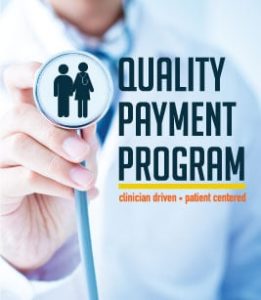 The Quality Payment Program under the Medicare Access and CHIP Reauthorization Act (MACRA) will commence on January 1st of the coming year. Last week the Acting Administrator of the Centers for Medicare and Medicaid Services (CMS), Andy Slavitt, announced that the agency would be offering providers four new compliance options that would not only prevent negative payment adjustments in 2019, but in some cases, would also allow for a small incentive payment.
The Quality Payment Program under the Medicare Access and CHIP Reauthorization Act (MACRA) will commence on January 1st of the coming year. Last week the Acting Administrator of the Centers for Medicare and Medicaid Services (CMS), Andy Slavitt, announced that the agency would be offering providers four new compliance options that would not only prevent negative payment adjustments in 2019, but in some cases, would also allow for a small incentive payment.
In his blog Slavitt noted that the CMS received feedback on the agency’s April proposal for implementing the Quality Payment Program, “both in writing and as we talked to thousands of physicians and other clinicians across the country.” He said that the overarching theme in the responses was that practitioners are most interested in a system that puts patients’ needs front-and-center, and he indicated that some of those specific comments and requests will be addressed in the final rule.
But for now, the CMS’s focus is on outlining options for reporting for the first year of the Quality Payment Program. Clinicians will be able to “pick their pace of participation” for the initial performing period that begins on January 1st. As long as practitioners adhere to one of the four compliance options available, they will avoid receiving the penalty of negative payment adjustments.
The four options for Quality Payment Program participation
The first option is set up as in introductory approach—it’s intended to prepare clinicians for broader participation in 2018 and 2019 and therefore will allow practitioners to avoid the negative payment adjustment by turning in some data to the Quality Payment Program (including data after January 1, 2017). Slavitt noted that this option allows participants to learn more as participation expands.
The second option provides for participation for only a portion of the calendar year. Clinicians can opt to submit Quality Payment Program data covering a certain number of days after January 1st; the practice may still be eligible for a small positive payment adjustment.
For instance, a clinician might submit information for a discrete period of the year about ways the practice is using technology, and what kinds of improvement activities it’s participating in, Slavitt said. Practitioners would be presented with a list of quality measures and improvement activities available under the Quality Payment Program and would be able to choose from the list.
The third option would allow practitioner groups that turn in quality-measures data for the full 2017 calendar year to be eligible for a modest positive payment adjustment.
The final option that Slavitt outlined involves an Advanced Alternative Payment Model for 2017. Participation in an Advanced APM such as Medicare Shared Savings Track 2 or 3 would be in lieu of reporting quality data as the other options require. Clinicians seeing a certain threshold of Medicare patients through an Advanced APM would be eligible for a five percent incentive payment in 2019.
Slavitt assures clinicians that the agency will offer assistance regardless of which option is chosen.
The demand for Medicare growing at a rapid pace
“As the baby boom generation ages, 10,000 people enter the Medicare program each day,” Slavitt wrote. “Facing that demand, it is essential that Medicare continues to support physicians in delivering high-quality patient care. This includes increasing its focus on patient outcomes and reducing the obstacles that make it harder for physicians to practice good care.”
The final rule is expected to be released by November 1st.
For more information/questions regarding any legal matters, please email [email protected] or call 310.203.2800.